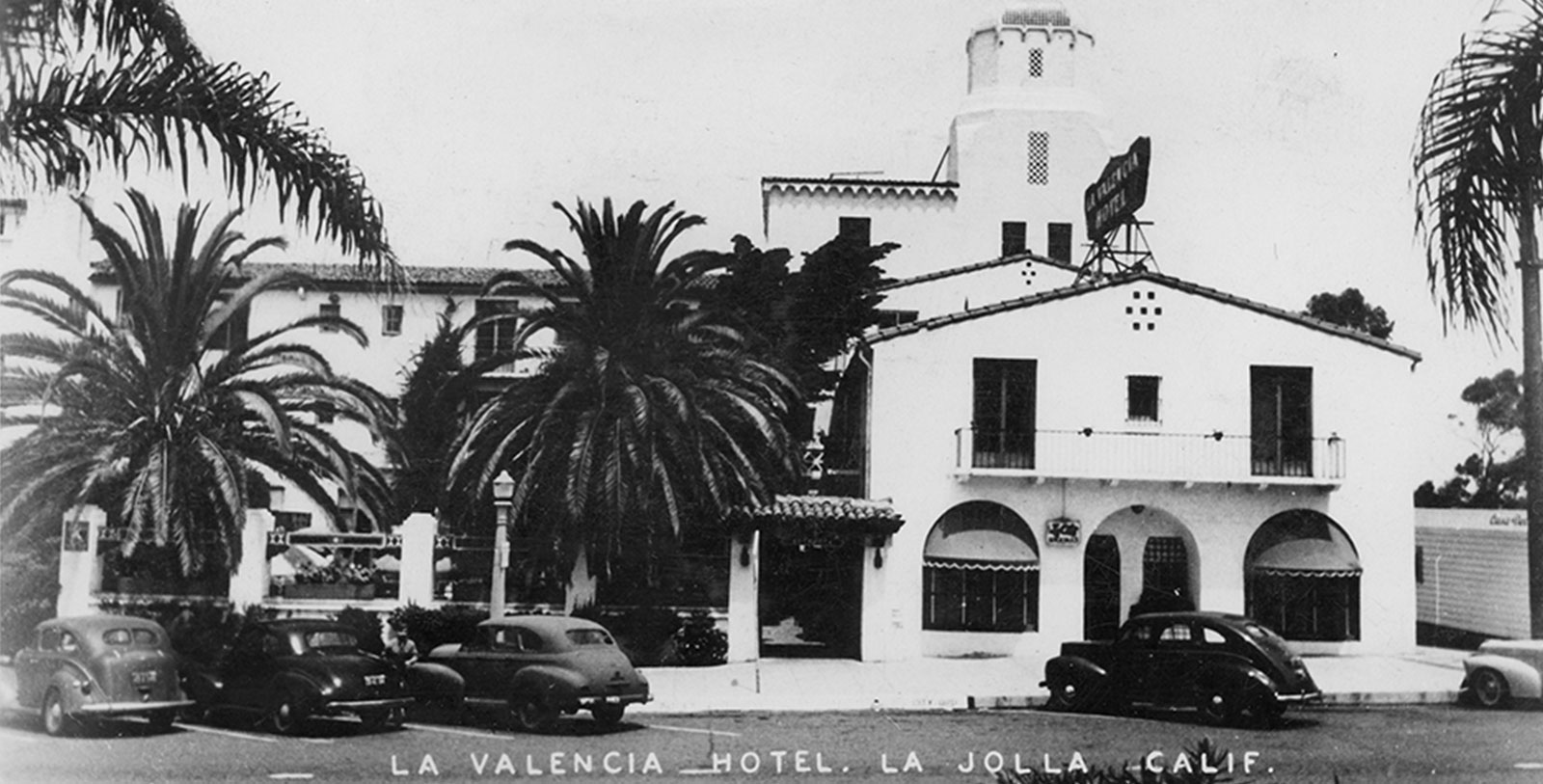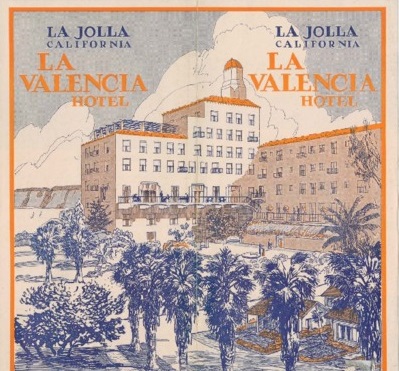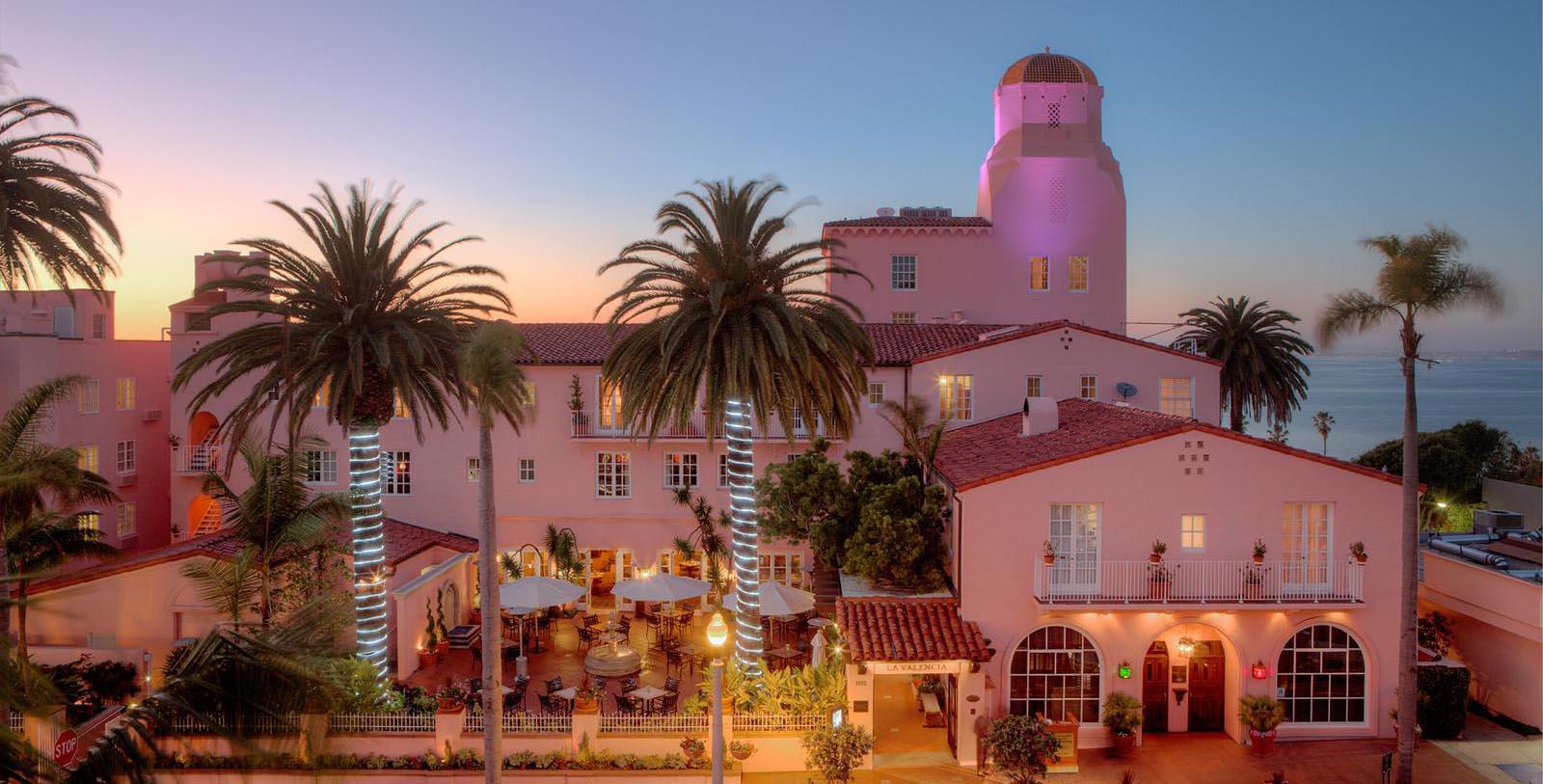Receive for Free - Discover & Explore eNewsletter monthly with advance notice of special offers, packages, and insider savings from 10% - 30% off Best Available Rates at selected hotels.
la valencia hotel history
Discover the La Valencia Hotel with a diverse and engaging choice of accommodations for every taste. 21st century additions include 16 luxury cabins and a salt water spa.
La Valencia Hotel, a charter member of Historic Hotels of America since 1989, dates back to 1926.
VIEW TIMELINEOne of the founding members of Historic Hotels of America, La Valencia Hotel is among southern California’s most sought-after holiday destinations. This spectacular vacation getaway made it grand debut in the winter of 1926, when La Jollans MacArthur Gorton and Roy B. Wiltsie opened it as an apartment hotel called “Los Apartmentos de Sevilla.” Perched atop a hill overlooking La Jolla Cove, the two men had spent several hundred thousand dollars to construct their magnificent new building. They hired architect Reginald Johnson to create its ornate appearance, who used a brilliant blend of Spanish Colonial Revival-style architecture as the source of their inspiration. Beautiful stucco tiling proliferated throughout its exterior, making the building one of the most iconic landmarks in La Jolla. Hundreds of guests subsequently attended its opening ceremony, which Gorton and Wiltsie threw at the height to the holiday season. Due to Gorton’s connections with Hollywood at the time, many of the age’s most illustrious celebrities attended the event. Word quickly spread across California of the hotel’s unrivaled elegance, encouraging people from all over the state to reserve a guestroom. Soon enough, Los Apartmentos de Sevilla was attracting hundreds of patrons every month. Groton and Wiltsie were even forced to expand the hotel’s facilities in 1928 as a means of addressing its dramatic rise in popularity.
Designed by Herbert J. Mann and Thomas L. Shepherd, the new addition was an eight-story unit that featured guestrooms for shorter overnight stays. It also contained a marvelous restaurant headed by a trained chef, and a lounge with a full-length balcony that faced the Pacific Ocean. A wealth of new architectural elements appeared inside, too, the most notable of which was a gorgeous tile mural. The image portrayed a Spanish woman who wore a pink, traditional “Sevilla” dress, as well as a shawl and a headpiece called a “mantilla.” In fact, the tile work impressed so many patrons that they took to calling the entire hotel the “Pink Lady of La Jolla. Yet, the single greatest feature the construction produced was a distinctive tower and its gold dome that dominated the hotel’s skyline. To commemorate the relaunch of the business, the two men renamed the building as the “La Valencia Hotel.” They had certainly spare no expense, as the final price on the construction reached a total investment of some $300,000! Thanks to the care demonstrated by Groton and Wiltsie, the reborn La Valencia Hotel managed to endure the tumult of the 1930s and 1940s. They even debuted two brand new fine dining establishments called “The Whaling Bar” and “Café la Rue,” which quickly became the centerpiece of the new hotel.
After serving as part of the national civil defense program during World War II, La Valencia Hotel entered into the golden years of its history. (Many hotel guests had joined patriotic La Jolla residents in climbing the tower to scan the skies for enemy aircraft.) Scores of celebrities also continued to seek refuge inside the building, many of whom had traveled to the area to perform at actor Gregory Peck’s renowned La Jolla Playhouse. Among the Hollywood luminaries to grace the hotel with their presence included the likes of Charlton Heston, David Niven, Jennifer Jones, and Joseph Cotton. Peck himself even visited the La Valencia Hotel on several occasions, regularly hosting his friends and colleagues at The Whaling Bar. Dozens of new facilities opened at the hotel as well, including an outdoor swimming pool, gym sauna, a putting green, and a shuffleboard. Three sprawling floors of additional guestrooms appeared, too, and the entire façade was painted in its iconic pink coloring. Then, in 1956, the historic Cabrillo Hotel next door was merged with the La Valencia Hotel, turning into its celebrated “West Wing.” As the 1960s gave way to the '70s and '80s, the hotel—like La Jolla itself—became not just a place for visitors looking for an exclusive vacation, but a social melting pot of those who lived and worked in La Jolla. Today, La Valencia Hotel still rates as one of the best places to stay on the West Coast. Its fantastic service and star-studded institutional history are both incredibly special.
-
About the Location +
La Valenica Hotel resides in the community of La Jolla, California, which is just a half-hour north of San Diego. Home to several thousand people, it is one of the most affluent cities in the entire United States with average home values in excess of a million dollars. Its renowned throughout the Golden State as a wonderful vacation getaway, due to its gorgeous shoreline and tranquil atmosphere. Yet, its history harkens back thousands of years, when Kumeyaay Native Americans occupied the land. The indigenous peoples called the area as “mat kulaaxuy,” meaning “land of holes.” While no archeological evidence clearly exists to explain the origin of the name, some local historians believe it was a direct reference to the many sea caverns that line present-day La Jolla’s coast. Local legend has it that when Spanish settlers eventually passed through the region centuries later, they transcribed the phrase as “La Joya,” or “The Jewel.” Nevertheless, Mexican officials incorporated the area as a part of San Diego, subdividing the locale into 60 plots for the development of pueblos. But the area remained relatively undeveloped, even after a flood of American citizens swept into the region shortly after California’s admission into the union in 1849. While some settlers did purchase a few modest acres of land, the nucleus of modern La Jolla did not appear until the end of the century. Two land developers from San Diego named Frank T. Botsford and George W. Heard began acquiring dozens of plots and auctioned them off at affordable prices. Their actions sparked a real estate boom that lasted throughout the 1880s. Countless commercial and residential structures emerged seemingly overnight, transforming the landscape to resemble the more densely populated regions to the south.
In 1893, a spur of the San Diego, Pacific Beach, and La Jolla Railway reached the area, which connected the nascent community directly to San Diego for the first time. As such, large amounts of people began traveling north into the region on trips to explore the local beaches and cliffs. A few aspiring hoteliers recognized the brilliant economic opportunity that the tourists presented, and immediately began constructing hotels and resorts to cater to their lavish tastes. Some folks began building their own seasonal vacation homes, constructing all kinds of rustic bungalows and cottages near the ocean. A massive tent city even materialized to help handle the overflow of people who visited during the summer months. Around the same time, an artist colony established itself inside La Jolla. Among its most famous members was journalist and publisher Ellen Browning Scripps, who subsequently lived in the community for a total of 35 years. Scripps herself was incredibly wealthy, having amassed her fortune from the estate of her late brother, as well as the royalties gained from her own writing. She proved to be very generous with her finances, investing much of it into La Jolla’s growth. Scripps’ selfless philanthropy led to the creation of many structures that served to benefit La Jolla as a whole. Her greatest contribution to the settlement was her monetary support for the construction of the Scripps Memorial Hospital, which opened in 1924. (Some of those building still exist today and are listed on the National Register of Historic Places.)
By the middle of the 20th century, La Jolla had become a playground for the nation’s wealthiest. Hollywood superstars were among the most frequent visitors to the area, including the likes of actor Gregory Peck, who established a brilliant theater known as the “La Jolla Playhouse” with Mel Ferrer and Dorothy McGuire. Many outstanding cultural attractions debuted around the same time as well, such as the Museum of Contemporary Art San Diego, which was originally founded inside the home of Ellen Browning Scripps. The University of California San Diego also opened within the community, too, as it was founded to help train the scientists and engineers employed at the nearby Scripps Institution of Oceanography. (The Scripps Institution of Oceanography bears the distinction of being the first oceanographic educational facilities in the country, having debuted in 1903.) And as the sport of surfing captured America’s imagination, La Jolla developed a reputation for having some of the best surf spots on the entire Pacific Coast. Today, La Jolla still rates as one of California’s most exclusive resort communities. Its serene ambiance, picturesque scenery, and fabulous cultural attractions guarantee that visitors will enjoy hours of entertainment and relaxation.
-
About the Architecture +
When Reginald Johnson first began designing the La Valencia Hotel’s iconic façade, he chose Spanish Colonial Revival-style architecture as the source of his inspiration. Johnson himself was a respected local architect in the 1920s, as he had developed a reputation for his deep understandings of historic Spanish-American culture. His work on the La Valencia proved to be so beautiful that many subsequent generations of architects endeavored to mimic his designs whenever they worked on the building. Also known as “Spanish Eclectic,” Spanish Colonial Revival-style architectural form is a representation of themes typically seen in early Spanish colonial settlements. Original Spanish colonial architecture borrowed its design principles from Moorish, Renaissance, and Byzantine forms, which made it incredibly decorative and ornate. The general layout of those structures called for a central courtyard, as well as thick stucco walls that could endure Latin America’s diverse climate. Among the most recognizable features within those colonial buildings involved heavy carved doors, spiraled columns, and gabled red-tile roofs. Architect Bertram Goodhue was the first to widely popularize Spanish Colonial architecture in the United States, spawning a movement to incorporate the style more broadly in American culture at the beginning of the 20th century. Goodhue received a platform for his designs at the Panama-California Exposition of 1915, in which Spanish Colonial architecture was exposed to a national audience for the first time. His push to preserve the form led to a revivalist movement that saw widespread use of Spanish Colonial architecture throughout the country, specifically in California and Florida. Spanish Colonial Revival-style architecture reached its zenith during the early 1930s, although a few American businesspeople continued to embrace the form well into the 20th century.
-
Famous Historic Guests +
Mary Pickford, actress known for her role in the silent film Coquette.
Ginger Rogers, actress and dancer remembered for her roles in such films like Kitty Foyle, Top Hat, and Swing Time.
David Niven, actor known for his roles in such films like Separate Tables, The Pink Panther, and Around the World in 80 Days.
Gregory Peck, actor known for such roles in Twelve O’Clock High, Gentleman’s Agreement, and To Kill a Mockingbird.
Lorne Green, actor best remembered for his role as “Ben Cartwright” on the television show, Bonanza.
Charlton Heston, actor known for his roles in such movies like Ben-Hur, El Cid, and Planet of the Apes.
Dorothy McGuire, actress best remembered for her roles in such films like Gentleman’s Agreement and Friendly Persuasions.
Mel Ferrer, actor known for his roles in such films like Scaramouche, Knights of the Round Table, and War and Peace.
José Ferrer, actor known for his roles in such films like The Shrike, and Cyrano de Bergerac.
Joseph Cotton, actor known for such roles in Shadow of a Doubt, The Third Man, and The Magnificent Ambersons.
Richard Basehart, actor best remembered for his role as Admiral Harriman Nelson in the television show, Voyage to the Bottom of the Sea.
Jennifer Jones, actress known for such roles in The Song of Bernadette and Love is a Many-Splendored Thing.
John Lennon, lead vocalist and rhythm guitarist for the legendary rock band, The Beatles.
Raymond Chandler, novelist known for such works as Farewell, My Lovely, The Little Sister, and The Long Goodbye.
Art Buchwald, Pulitzer Prize-winning columnist who spent years working for the Washington Post.
Theodor Geisel, children’s author and political cartoonist best remembered today as “Dr. Seuss.”






































